
NFPA (Fire) 70E
- Comments Off on NFPA (Fire) 70E
- NFPA-FIRE
Product Details
- Published:
- 04/23/2023
- ANSI:
- ANSI Approved
- Number of Pages:
- 117
- Note:
- This product is unavailable in Ukraine, Russia, Belarus




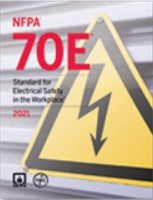
Click here to purchase
Please Note: NFPA has decided not to release this edition of this code as a PDF.
Access the latest criteria and stay up to date on electrical workplace safety with NFPA 70E®, 2021 edition.
While the number of workplace electrical injuries has declined in recent years, the risks of shock, electrocution, arc flash, and arc blast remain a significant health and safety concern. Each week nearly three workers die, and annually thousands are injured by electrical hazards. Many of these incidents could have been prevented through compliance with the latest safety codes and standards.
NFPA 70E, Standard for Electrical Safety in the Workplace®, is the quintessential resource for helping companies and employees reduce exposure to risks and reduce occupational injuries and fatalities. It was created to provide a document that meets the need of the Occupational Safety and Health Administration (OSHA) and is entirely consistent with the NEC and other applicable publications.
The electrical industry is always changing. Make sure you have access to the information you need to prepare for the challenges of the modern electrical workplace.
NFPA 70E provides provisions that help comply with OSHA 1910 Subpart S and OSHA 1926 Subpart K. This essential standard for anyone with interest in ending electrical-related accidents, liability, and loss offers expert information on subjects ranging from safety-related work practices to special equipment and maintenance requirements. Informative Annexes provide in-depth coverage of personal protective equipment (PPE), developments in electrical design, risk assessment and control, human performance and electrical safety, and many other critical topics.
The new 2021 edition features extensive changes, including:
Help make sure everyone on the job gets home safe. Give your team the knowledge required to help put your safety program on the cutting edge.
Electricians, contractors, risk managers, engineers, building managers, owners, and others at risk or with responsibilities maintaining an electrically safe workplace rely on NFPA 70E, along with NFPA 70®, National Electrical Code®, and NFPA 70B, Electrical Equipment Maintenance. Get up to date with the most current requirements by placing your order for the Standard for Electrical Safety in the Workplace, 2021 edition, today.




Click here to purchase
Electrical dangers such as shock, electrocution, arc flash, and arc blast will always be present on the job, but proper training and safety strategies can minimize the likelihood of injuries and fatalities. NFPA 70E – Electrical Safety in the Workplace – covers the full range of electrical safety issues from work practices to maintenance, special equipment requirements, and installation. In fact, OSHA bases its electrical safety mandates on the comprehensive information in this important Standard.



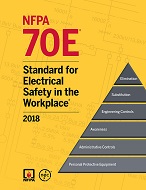
Click here to purchase
Keep the workplace safe from electrical hazards using the 2018 edition of NFPA 70E®.
In a fraction of a second, an electrical incident can claim lives and cause permanently disabling injuries. In fact, hundreds of deaths and thousands of burn injuries occur each year due to shock, electrocution, arc flash, and arc blast — and most could be prevented through compliance with NFPA 70E: Standard for Electrical Safety in the Workplace®.
Originally developed at OSHA’s request, NFPA 70E responds to the latest information about the effects of arc flash, arc blast, and direct current (dc) hazards, and recent developments in electrical design and Personal Protective Equipment (PPE). It provides vital information that helps you comply with OSHA 1910 Subpart S and OSHA 1926 Subpart K.
Make sure everyone goes home at night. New NFPA 70E explicitly states that the first priority must be the elimination of the hazard.
The Standard continues to evolve to address risk assessment and introduces human factors, such as human error, as part of that assessment. Annex Q, Human Performance and Workplace Electrical Safety, is included to provide guidance. NFPA 70E emphasizes the need to use the hierarchy of risk controls, by moving it from an informational note into the text of the Standard. NFPA 70E now explicitly states that the first priority must be the elimination of the hazard.
Other changes in this edition:
Bring your company’s electrical safety program up-to-date and give employees critical knowledge.
If you’re responsible for ensuring workers are protected from shock and arc flash hazards, use the 2018 edition of NFPA 70E along with NFPA 70 ®: National Electrical Code®: (NEC®:) and NFPA 70B: Electrical Equipment Maintenance.. Together, the “Big Three” help you protect your personnel and your company from tragic loss. NFPA 70E is a vital tool for contractors, risk managers, engineers, building managers, owners, and everyone concerned with ending electrical-related accidents, liability, and loss.



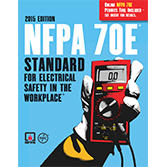
Click here to purchase
NFPA 70E® compliance saves lives, reduces liability, and helps avoid unexpected downtime and revenue loss. Now, the 2015 Standard takes another big step in changing the way America works.
In a fraction of a second, an electrical incident can claim lives and cause permanently disabling injuries. In fact, hundreds of deaths and thousands of burn injuries occur each year due to shock, electrocution, arc flash, and arc blast — and most could be prevented through compliance with NFPA 70E: Standard for Electrical Safety in the Workplace®. Originally developed at OSHA’s request, NFPA 70E responds to the latest information about the effects of arc flash, arc blast, and direct current (dc) hazards, and recent developments in electrical design and Personal Protective Equipment (PPE).
The 2015 NFPA 70E helps you assess electrical risks on the job, making users more aware of the potential for devastating loss.
The 2015 edition of NFPA 70E introduces a major change in how stakeholders evaluate electrical risk — so that owners, managers, and empolyees can work together to ensure an electrically safe working area and comply with OSHA 1910 Subpart S and OSHA 1926 Subpart K.
Bring your company’s electrical safety program up-to-date and give employees the know-how to be electrically safe.
If you’re responsible for ensuring workers are protected from shock and arc flash hazards, use the 2015 NFPA 70E along with the 2014 NFPA 70®: National Electrical Code® (NEC®) and the 2013 NFPA 70B: Electrical Equipment Maintenance. Together, the “Big Three” help you protect your personnel and your company from tragic loss. NFPA 70E is a vital tool for contractors, risk managers, engineers, building managers, owners, and everyone concerned with ending electrical-related accidents, liability, and loss.



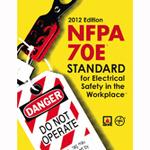
Click here to purchase
Lives depend on you! Protect your personnel from electrical hazards and meet the highest standard for electrical safety with the 2012 edition of NFPA 70E®.
Workplace safety in the United States is evolving due to better awareness and implementation of NFPA 70E: Standard for Electrical Safety in the Workplace?. Yet hundreds of deaths and thousands of disabling injuries still occur each year due to shock, electrocution, arc flash, and arc blast — and most could be prevented through NFPA 70E compliance. The 2012 NFPA 70E responds to the challenges, making it easier to ensure an electrically safe working area and comply with OSHA 1910 Subpart S and OSHA 1926 Subpart K.
Get new ways to calculate risks and mitigate hazards.
Originally developed at OSHA’s request, NFPA 70E responds to new information about the effects of arc flash, arc blast, and direct current (dc) hazards, and recent developments in electrical design and Personal Protective Equipment (PPE).
Coverage of direct current hazards is the first of its kind in the U.S.
The rising demand for alternative energy systems such as photovoltaic and wind power present greater dc shock and arc flash hazard exposures to workers. To protect personnel, NFPA 70E includes a new shock protection boundary, hazard/risk table, and incident energy calculation for direct current systems. Revised Article 320 focuses on safe work practices for stationary batteries and battery rooms, such as those used by alternative energy systems.
Make hazard/risk assessments and select proper PPE.
Give your employees the know-how they need to be electrically safe on the job!
Training and audit-related revisions impact your company’s electrical safety program. The 2012 NFPA 70Eexplains when the energized work permit (EWP) is required and what it should contain; requires emergency procedure instruction on AEDs (Automatic External Defibrillators), adds a new three-year maximum interval for employee training and documentation of content, and more. This edition also contains new information about implementing NFPA 70E within the framework of ANSI/AIHA Z10 and other health and safety management standards.
Order your copy of the new NFPA 70E, the Standard that’s changing the way America works!
If you’re responsible for ensuring workers are protected from shock and arc flash hazards, order NFPA 70Enow to protect personnel and your reputation for safety. Contractors; risk managers; engineers; apartment, commercial, and retail building managers; and owners all have a stake in ending electrical-related accidents, liability, and loss.



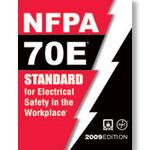
Click here to purchase
Avoid accidents and OSHA fines with the 2009 NFPA 70E®: Standard for Electrical Safety in the Workplace®!
Shock, electrocution, arc flash, and arc blast are responsible for hundreds of worker deaths and thousands of injuries per year in the U.S. alone. Save lives with NFPA 70E: Electrical Safety in the Workplace, the Standard developed for OSHA that details the “hows” behind compliance with OSHA 1910 Subpart S and OSHA 1926 Subpart K.
The 2009 edition is revised to recognize new hazards and increase safety on the job.
Personal Protective Equipment (PPE) protects personnel and can significantly reduce the risk of injury in an arc flash. To help engineers calculate incident energy–the first step in determining the correct type of PPE for a given task-a new Annex D in the 2009 NFPA 70E consolidates all equations, adds new tables, and offers more options to detailed calculations. For example, a new utility table derived from the NEC helps utility and industrial plant workers calculate PPE based on voltage and fault current data.
Improved work practices reduce risks:
Other changes expand your know-how:
Engineers, designers, risk managers, maintainers, safety directors, contractors, and owners need the 2009 NFPA 70E to improve worker safety and avoid citations, rising insurance fees, and increased workman’s comp costs.



